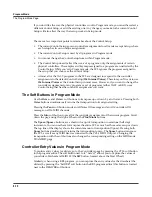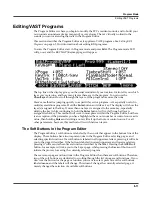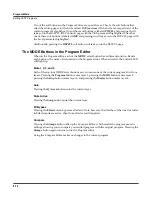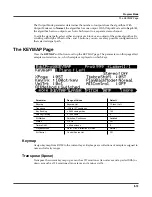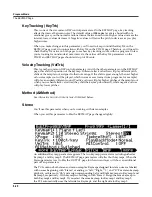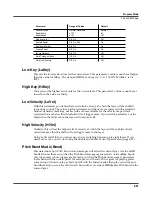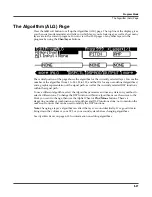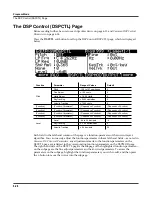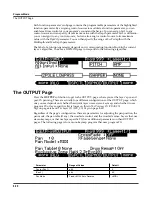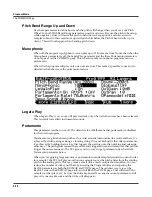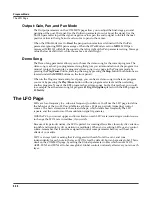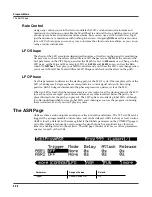
6-24
Program Mode
The LAYER Page
Trigger (Trig)
Set Trig to
Rvrs
to have notes triggered on key-up. The initial velocities of notes triggered this
way are determined by the release velocities of the keys that trigger them. The default setting is
Norm
.
Delay Control (DlyCtl)
Here you select, from the Control Source list, a control source that will delay the start of all notes
in the current layer. The length of the delay is determined by MinDly and MaxDly (described
below). You’ll assign a continuous control like MWheel for the DlyCtl parameter when you
want to vary the delay time, and a switch control if you want the delay to either be its minimum
value (switch off), or its maximum (switch on). The delay control will affect only those notes
triggered
after
the delay control source is moved; the delay time is calculated at each note start,
based on the status of the delay control source at that time.
Minimum Delay (MinDly), Maximum Delay (MaxDly)
The length of the delay is determined by these two parameters. When the control source
assigned to DlyCtl is at its minimum, the delay will be equal to the value of MinDly. The delay
will be equal to the value of MaxDly when the control source is at its maximum. If DlyCtl is set
to
OFF
, you get the minimum delay. If it’s set to
ON
, you get the maximum delay. This doesn’t
change the note’s attack time, just the time interval between the Note On message and the
start
of the attack. The delay is measured in seconds.
Enable
This assigns a control source to activate or deactivate the layer. When the value of the assigned
control source is between the minimum and maximum thresholds set by the Sense (S)
parameter, the layer is active. When the value of the assigned control source is below the
minimum or above the maximum, the layer is inactive. By default, many layers have the Enable
parameter set to
ON
, so the minimum and maximum thresholds don’t matter. They’re relevant
only when Enable is set to a specific control source (like MWheel).
Some local control sources (KeyNum and AttVel, for example) are not valid for the Enable
parameter. In these cases, you should use the global equivalent (GKeyNum and GAttVel in this
example).
Enable Sense (S)
This parameter determines how and when a layer is enabled by the control source assigned for
the Enable parameter. Enable Sense has three values: orientation, minimum, and maximum.
Suppose for a moment that you’re editing a program, and in the current layer you’ve set the
value of Enable to
MWheel
, which causes the Mod Wheel to control whether the layer is active.
The default values for Enable Sense are as follows: orientation is
Norm
; minimum is
64
, and
maximum is
127
. This means that when the Mod Wheel is less than halfway up, the layer is
disabled. The layer plays only when the Mod Wheel is more than halfway up.
Change the orientation to
Rvrs
, and the layer plays only when the Mod Wheel is
less
than
halfway up. Change the orientation back to
Norm
, and change the minimum to
127
. Now the
layer plays only when the Mod Wheel is
all
the way up.
Содержание PC3
Страница 24: ...1 6 Introduction Options ...
Страница 50: ...4 4 The Operating Modes Using the Modes ...
Страница 174: ...7 54 Setup Mode The Utility Soft Buttons ...
Страница 178: ...8 4 Quick Access Mode Making Your Own QA Banks ...
Страница 204: ...9 26 Effects Mono Algorithms ...
Страница 266: ...A 2 MIDI Implementation Chart ...
Страница 308: ...Index x ...

